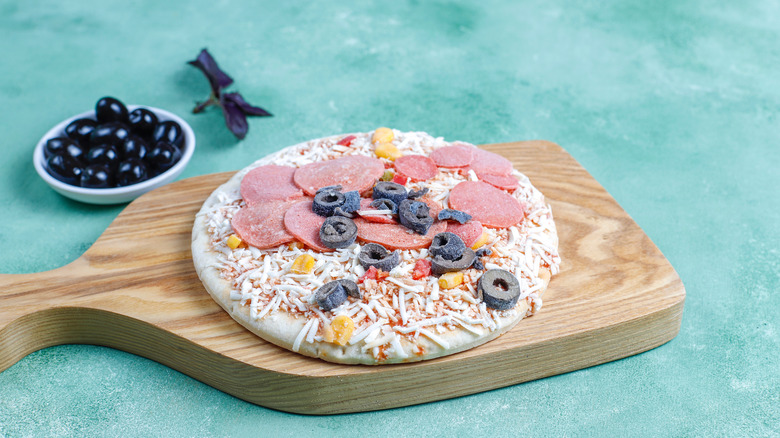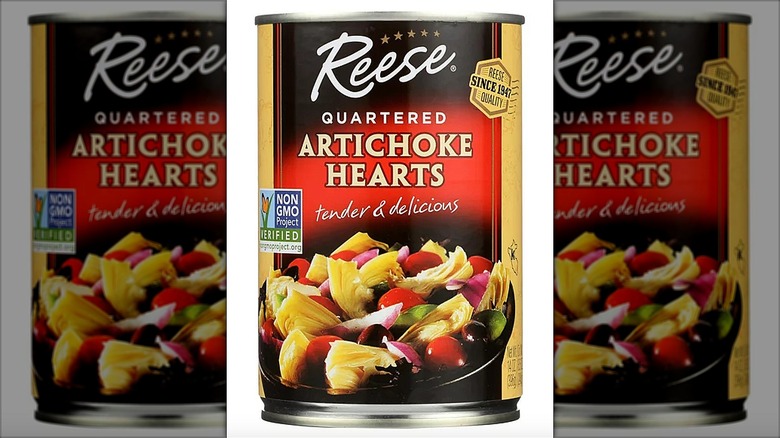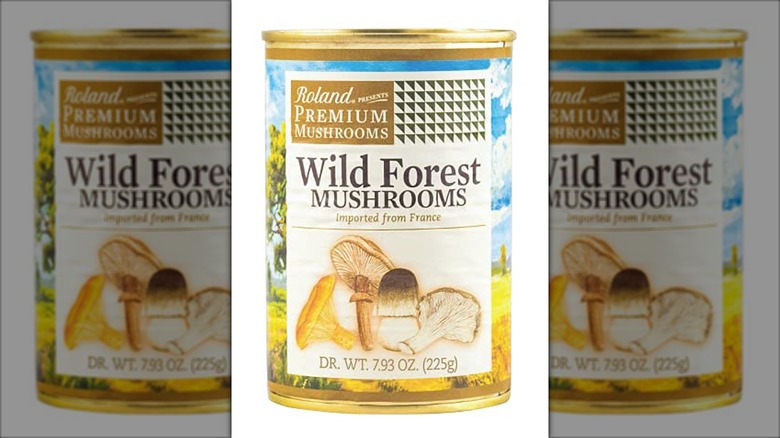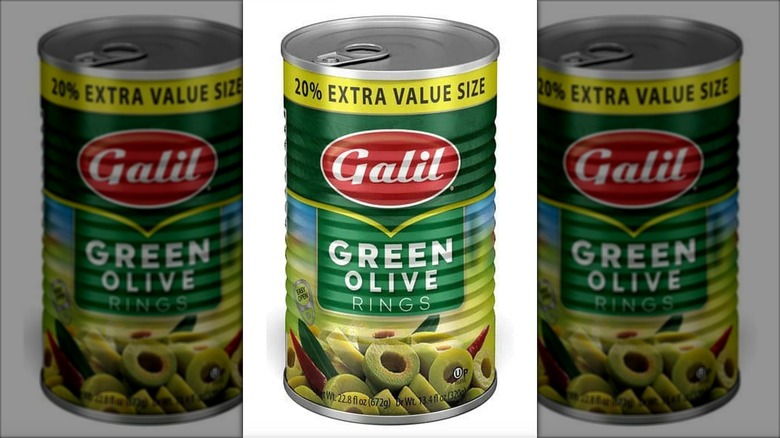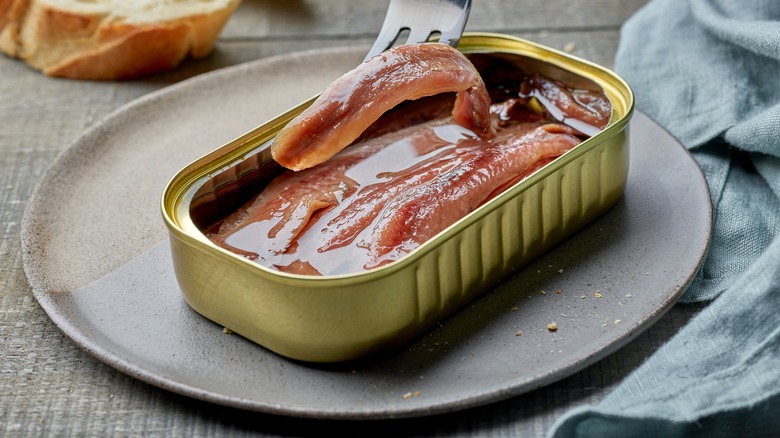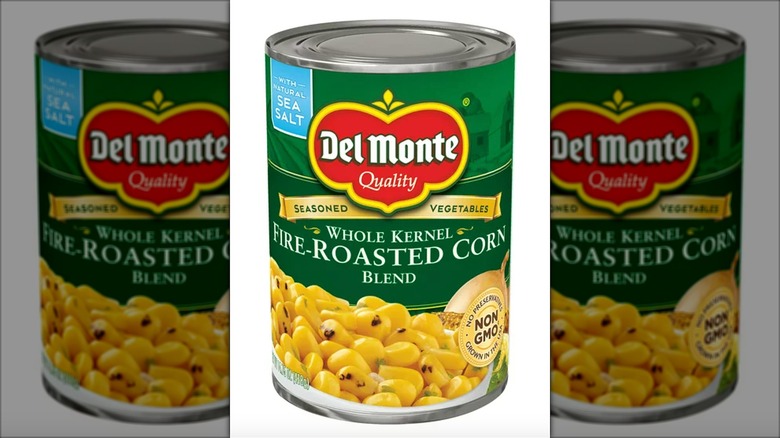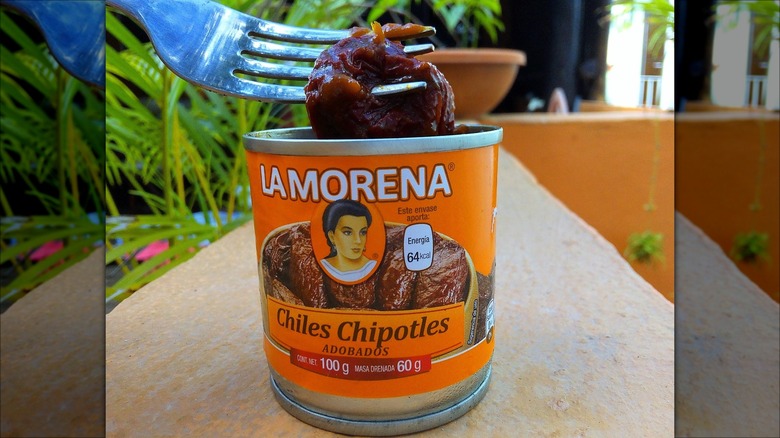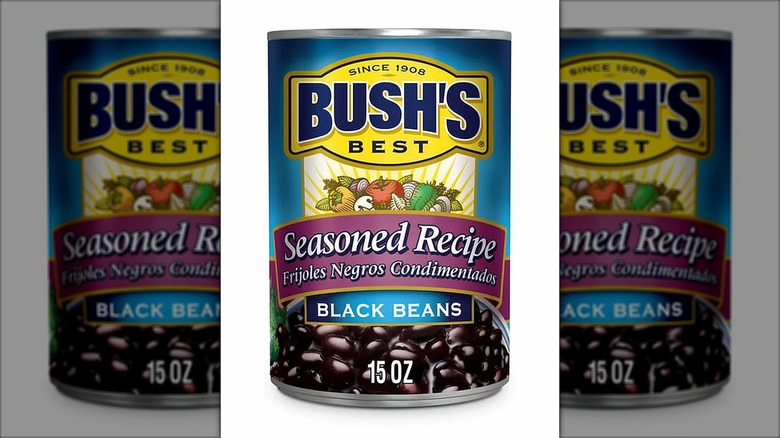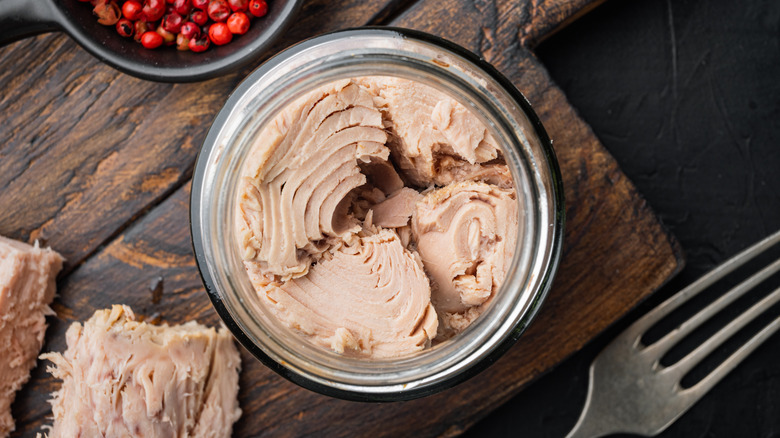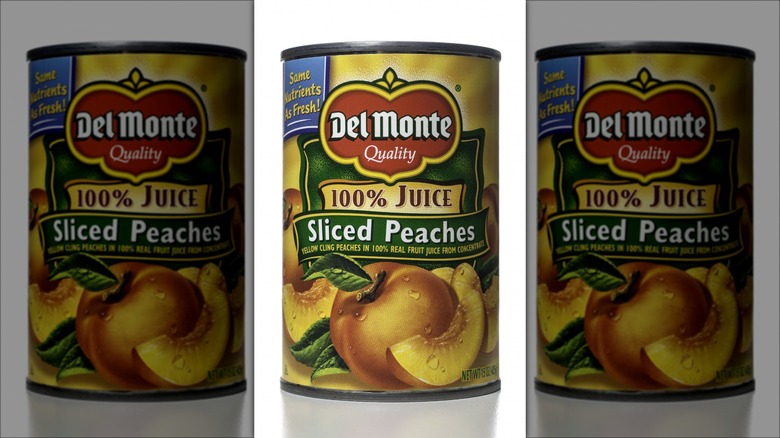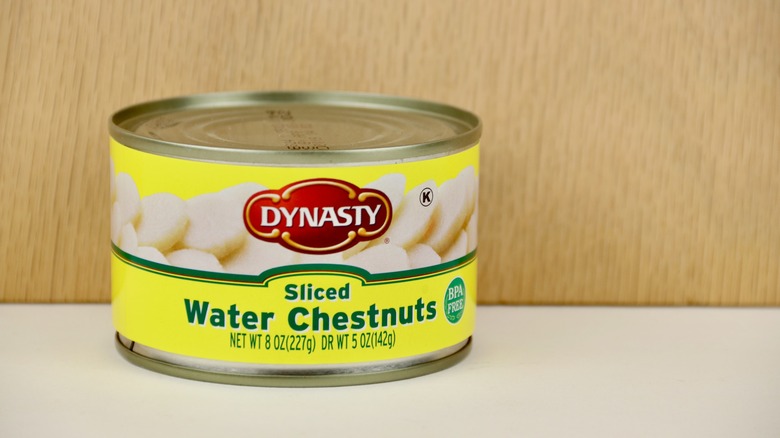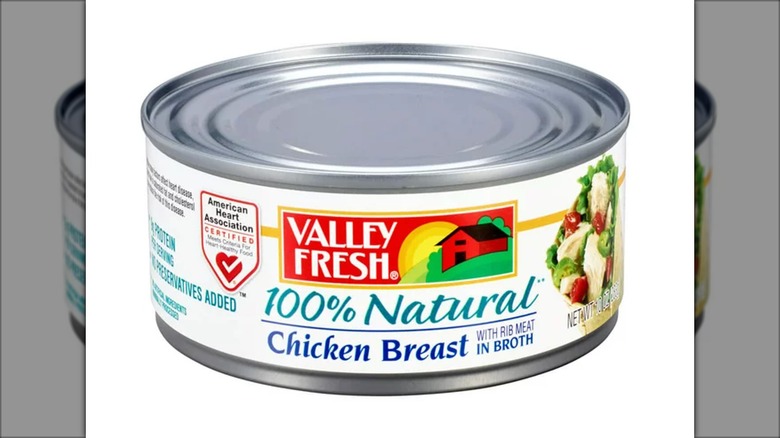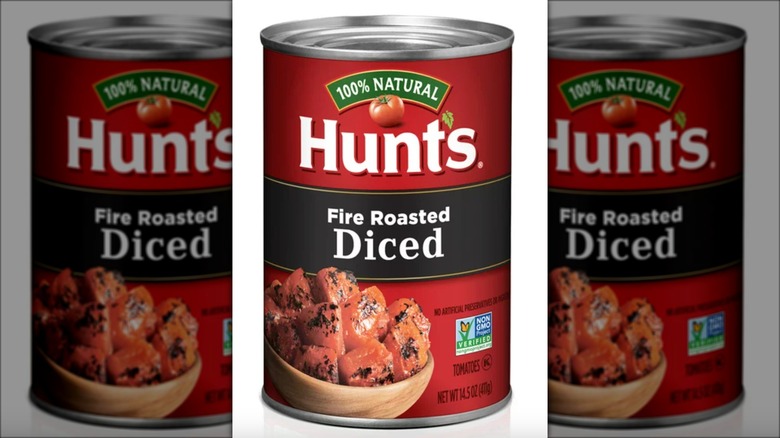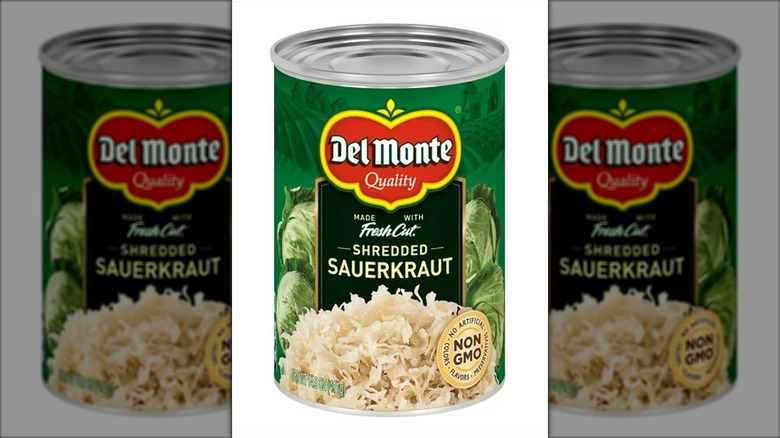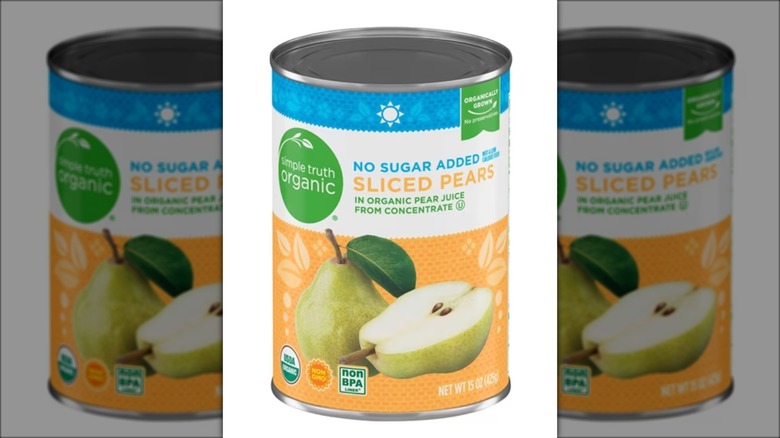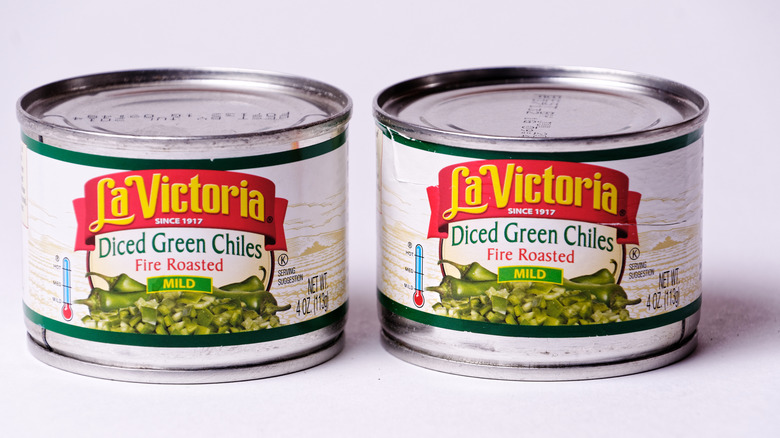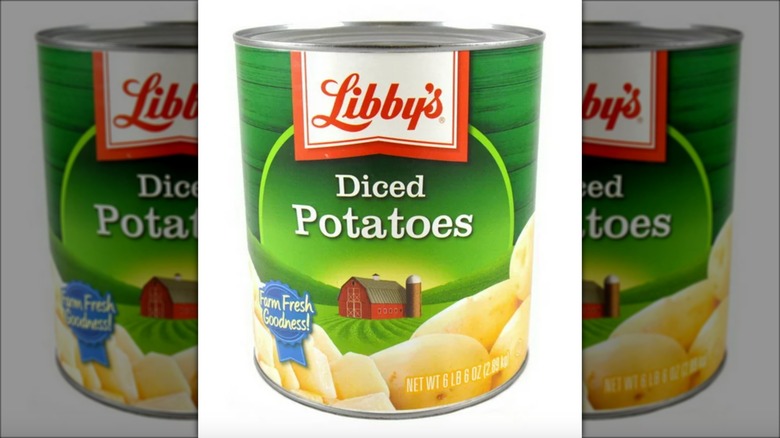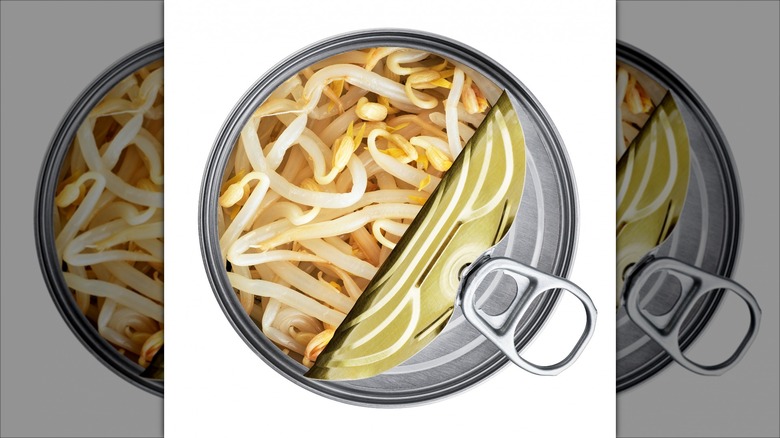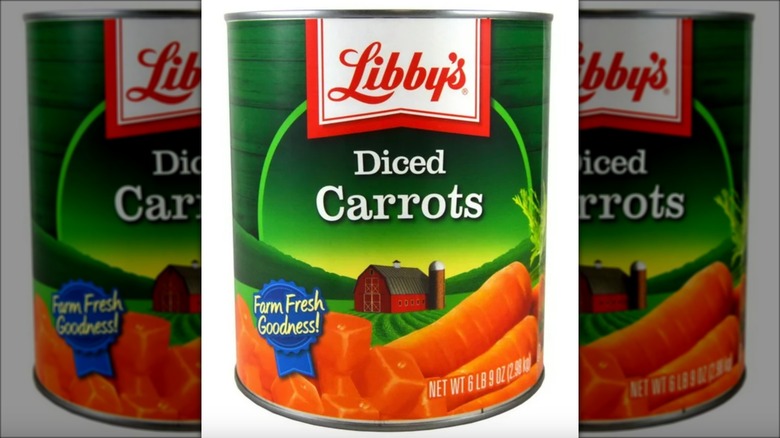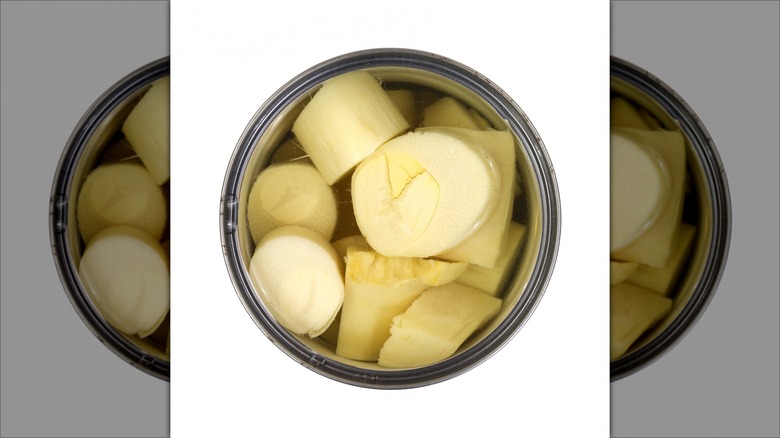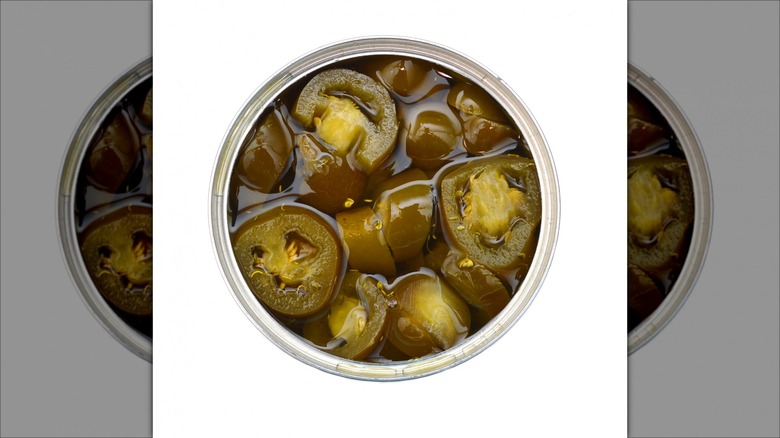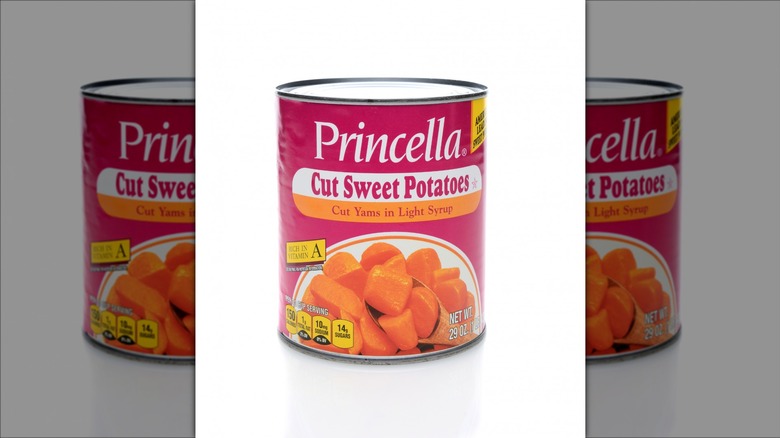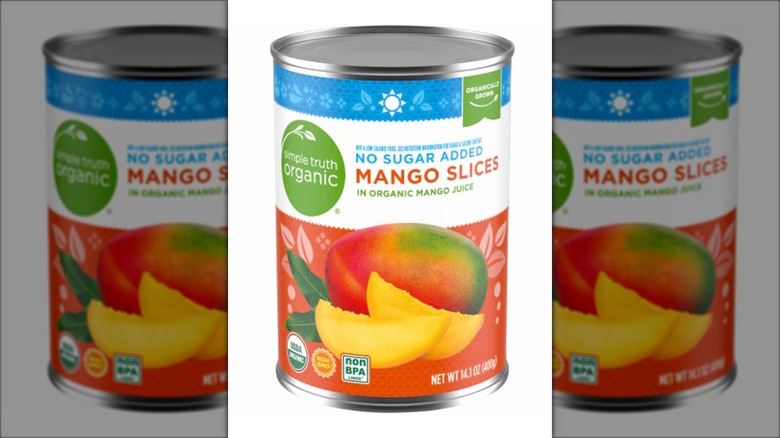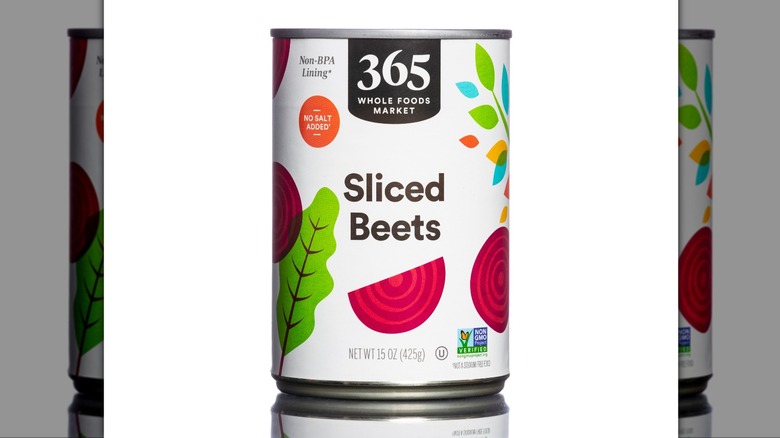Canned Ingredients That Will Make Frozen Pizza Even Better
If you love pizza, you are not alone. Whether you want thin crust, thick crust, gluten-free, or vegan options, pizza can accommodate any lifestyle. And let's be honest, on a busy weeknight when you are tired and need to feed a family quickly and cost-effectively, what could be easier than popping a frozen pizza in the oven?
With the number of frozen options skyrocketing, more Americans are turning to these store-bought pies than ever before. According to Grand View Research, profits from the sale of frozen pizza exceeded $6.6 billion in 2022, and the segment is anticipated to continue expanding at a clip of 6.9% in the coming years.
Even with the market diversifying and expanding, sometimes a frozen pie can't compare with a fresh, hot pizza made from scratch or delivered from a favorite local pizzeria. To help spruce up your next frozen pie, consider doctoring it up using ingredients that are affordable, convenient, namely canned goods. Let's examine some of the best options to keep on hand for your next frozen pizza emergency.
Artichoke hearts
Adding artichoke hearts to pizza isn't just delicious; it makes historical sense. Italians are avid artichoke consumers, eating them stuffed, braised, and roasted. This thorny delicacy is intimidating to clean from its freshly picked iteration. When purchased already prepared in a can, they become perfect little nuggets to add to salads, dips, and as a pizza topping.
We recommend using a frozen white pizza, a meat pizza, or vegetarian pizza as a base. While you can get halved artichoke hearts in a can, we recommend the quartered variety. These smaller pieces have more surface area that will get exposed to the heat of your oven, which enables them to begin crisping up a bit. This will give them a delectable nutty flavor. Before you add them to your pizza, drain and pat them dry to ensure you eliminate any excess moisture that can make your frozen pizza soggy.
Pineapple chunks
We are not here to debate the legitimacy of putting pineapple on a pizza. Hawaiian pizza happens to be one of our favorites. The idea of combining sweet and savory flavors isn't a new one. Many cultures across the globe regularly pair fruit with meat for a reason. Ultimately it is about the juxtaposition of flavors and developing nuanced notes on your palate of umami, salt, and sweet.
While you can purchase frozen Hawaiian pizza, we recommend getting a supreme, meat lover, or vegetarian pizza and adding canned pineapple chunks in 100% juice rather than sliced. Drain the pineapple chunks and pat them dry before adding them to your pizza. And don't use too many. As pineapple cooks in the oven, it will continue leaching some liquid. Too many will drown your pizza. Remember, it is about balance in flavor and texture.
Mushrooms
Mushrooms on pizza is not exactly a novel idea. It is a common ingredient thanks to the intense umami-forward profile of these fantastic fungi, which can amp up the flavor of virtually any dish. That said, canned mushrooms may be better for pizza than fresh mushrooms. Mushrooms tend to leach a lot of moisture as they cook. Fresh mushrooms on a pizza will swamp the pie and make it soggy.
Canned mushrooms are typically cooked before the canning process, making them less likely to drown your pizza. Since frozen pizza bakes rapidly, you will not have to worry about your mushrooms becoming rubbery in the baking process. Rather than using plain button mushrooms, try stocking up on seasoned mushrooms or assorted wild forest varieties. These have a more intense flavor and better texture. Again, do not skip draining and patting your mushrooms dry before adding them to your frozen pie.
Olives
Olives tend to be polarizing foods. We love the saltiness and hint of bright brininess they add to a pizza. Though we often mix sliced black and green olives on our pizza, you may wonder which to stock in your pantry.
Green olives are harvested before they ripen. They usually have a firmer texture and notable acrid flavor. Black olives are picked when they are fully ripe before they are cured. They tend to be softer in texture and more subtle in taste unless they are aggressively cured in salty brine.
Which you select to top your pizza is a matter of taste. If you want to temper the bitterness, consider using sliced pimento-stuffed olives. The slightly sweet peppers can help mellow the acrid undertones of the green olive. Whichever type of olive you use, don't forget to drain and pat them dry before adding.
Anchovies
Another controversial topping for pizza is anchovy. These little fish can pack an umami punch on top of a frozen pizza, transforming it to a new level. The key is understanding how to use them and which kind to purchase.
Contrary to popular belief, good anchovies shouldn't have an aggressively fishy flavor once cooked. The best ones are typically sourced from the Mediterranean and brined in olive oil. They should be plump, not emaciated, and you should always drain, rinse, and dry them before adding them to your frozen pizza.
To fully appreciate anchovies, avoid frozen pizzas with aggressively salty ingredients, like lots of meat or parmesan cheese. A simple margherita is where anchovies will provide the best flavor. As the anchovy begins to bake, it'll yield an almost sweet, salty flavor that'll complement the tomato, mozzarella, and basil.
Corn
Eating an ear of freshly harvested summer sweet corn on the cob is one of the great pleasures in life. But did you know that canned corn can be as nutritious and delicious as fresh corn? It is generally canned right after being picked, preserving all the sweetness, vitamins, and minerals we can store in our pantries to use year-round.
Canned corn can provide a bright, sweet pop of flavor on a vegetarian, Southwestern, Thai, or barbecue chicken-flavored pie. In fact, the spicier the pizza, the more the taste and texture of the canned corn will pop. Be careful not to use creamed corn. Always opt for whole-kernel corn. And if you can find it, we highly recommend fire-roasted corn, which has a slightly nutty flavor that'll send your pizza into the stratosphere. Again, don't forget to drain, rinse, and dry your corn before use.
Chipotles
For the uninitiated, chipotles are dehydrated smoked jalapeños. These often get canned in an adobo sauce, a condiment made of smoked chilis, tomatoes, garlic, onions, vinegar, and spices. Chipotles are distinct because they have a unique earthiness balanced with a hint of sweetness that helps to mitigate their heat. This flavor profile is what makes it an ideal frozen pizza topper.
While peppers are common pizza ingredients, chipotles can confer a spiciness that accentuates meat, vegetarian, or Southwestern pizzas without overwhelming them when used in moderation. You will want to drain the chipotles from the adobo sauce, but don't rinse them. We recommend chopping them finely and spreading them evenly across the pizza for the best flavor. A couple of peppers should be more than adequate to cover a standard 12-inch diameter frozen pizza.
Black beans
Beans on pizza may seem a little bizarre, but if you think about it, pizza is like an Italian nacho. Instead of tortilla chips topped with salsa, cheese, beans, and meat, you cover the dough with a different tomato base and similar ingredients. It's a no-brainer. And, if you are trying to cut back on meat, beans can be a great source of protein and fiber.
We like black beans instead of other beans because of their petite size and distinct firm texture that can withstand being subjected to high-heat cooking techniques, like baking in an oven. Try adding them to a vegetarian frozen pizza to create a Southwestern delight. If you can locate them, seasoned black beans will provide an added layer of flavor. Just drain and rinse them to remove excess sodium, and pat them dry before covering your frozen pie.
Tuna
Putting tuna on pizza isn't as foreign as you might think. If you look at the etymology of the word marinara, it means sailor-style, signaling its popularity with Italian seafood merchants. Italy is not the only country known for adding fish to pizza. Germans have a particular affinity for canned tuna on a pie called thunfisch pizza.
We recommend using tuna canned in oil versus water, as the brine can make the tuna a bit acrid. Look for varieties that have been sustainably sourced and that aren't preserved with too many additional flavorings, like balsamic or garlic. Let the tuna shine on its own. Although you can add canned tuna to a vegetarian pizza, it pairs best with fewer ingredients, like a margherita. Don't forget to drain the tuna and crumble it into flakes atop your frozen pie.
Peaches
Here we go again with the fruit on pizza. It is not an unheard-of concept. Peaches are stellar when wrapped in prosciutto di Parma and drizzled with aged balsamic vinegar. It is also a popular ingredient in a variation of a Panzanella salad. Placing it atop a frozen pizza is a match made in Italian heaven.
We suggest skipping the vegetarian pizza and going for a meaty pizza with salty cured ingredients like pepperoni. The salinity of the cured meat will be offset by the sweet peach slices, creating a complex flavor in your mouth. It is crucial to select sliced canned peaches packed in water rather than heavy syrup. Drain the peaches and pat them dry before distributing them evenly across your pie. As they bake in the oven, their natural sugars will begin to caramelize, leaving a nutty aftertaste.
Water chestnuts
Despite its name, water chestnuts bear no relation to the tree nut. They are root vegetables indigenous to Southeast Asia, Australia, and the Pacific islands. These tubers thrive in moist climates, like rice paddies, marshes, and ponds. Their corm, or root base, has a distinctive crunchy, moist texture, ideal in stir-fries and salads. Their flavor is slightly nutty with a delicate sweetness.
You can obtain canned water chestnuts in whole or sliced forms. We recommend keeping the sliced variety on hand to add to an Asian-inspired frozen pizza. Begin with a vegetarian or supreme pizza base. Drain, rinse, and pat the water chestnuts dry before adding them to your pie. Even after heating, they will retain a quintessential toothsome bite that can confer textural interest to your frozen pizza.
Chicken
Though you can purchase frozen pizza with chicken already on it, sometimes the chicken can dry out when you bake the pie. That said, chicken is a reliable source of lean protein, and more people are opting for it over red meat or processed varieties like sausage or pepperoni on pizza. A better option for topping your pie is canned chicken from your pantry.
But is it healthy? Most health experts say yes, according to Vibrant Happy Healthy. It can be a great, quick, affordable, shelf-stable option if you choose the type you purchase judiciously. Look for canned varieties that are low-sodium and have the fewest possible ingredients on the nutrition label. You may also want to stick with white meat chicken versus dark meat for the leanest choice. Before using canned chicken, drain it thoroughly and pat the meat dry.
Fire-roasted tomatoes
Many pizzas are made with a tomato-based sauce or marinara, so putting them on a pie isn't revolutionary. That said, we are big fans of canned fire-roasted tomatoes. We keep these on hand for myriad recipes, from homemade sauces to soups and stews. They are slightly less acidic than plain canned tomatoes and have a delightful smokiness that helps impart a distinct flavor balancing out any added sweetness.
When putting these on a frozen pie, we recommend doctoring up a white pizza or a non-tomato-based option. Though it may seem wasteful, a lot of excess moisture is added to these cans, so drain them to help concentrate the meat of the fruit. Once you have done this, you can spread the tomato chunks over your pie before baking it. Instead of the tomato being one of the stars, it becomes a supporting player, making it a more nuanced show.
Sauerkraut
If the idea of putting sauerkraut on a pizza makes you want to run for the hills, let us remind you that pickle pizza is a thing, and it has a cult-like following. The slightly vinegary and salty taste of fermented foods helps to impart an umami bomb of flavor on your pizza, balancing out the gooey cheese and taming the acidity of the tomato sauce. As a bonus, these fermented ingredients are loaded with probiotics which are great for our gut health.
Though you can add the sauerkraut to a plain cheese pizza, we love putting it on a pepperoni pie. The salty cured meat paired with the slightly sour fermented cabbage reminds us of a childhood dish with Polish sausage. When using canned kraut, it is crucial that you drain and thoroughly rinse the cabbage before patting it dry and using it on the pie, or it can be overly salty and acrid.
Pears
One of the salads we repeatedly go to combines pears with gorgonzola, prosciutto, and candied nuts. The idea of this grouping balances flavors as well as textures, which easily translates to a pizza. Pears have a subtle sweetness and a tender texture that can become almost creamy when heated. This makes them popular fruits for baking and poaching. The key is to choose the right kind.
When selecting canned pears, choose the sliced variety packaged in pear juice from concentrate rather than syrup. This will eliminate any cloying residual sweetness. We recommend using these atop a frozen white pizza with strong cheeses or a meat pizza with cured salami and pepperoni. You will want to avoid a vegetarian pizza or something with too many ingredients. Don't forget to drain and pat your pear slices dry before distributing them onto your frozen pizza.
Green chiles
Green chilies are typically those picked when small, unripened, and mild in spiciness. The most common varieties to can are Anaheim, poblano, and pasilla. Once harvested, these peppers are roasted, peeled, and canned whole or diced. They are fabulous in myriad dishes because they confer heat without overwhelming spiciness.
Their flavor is slightly earthy, with sweetness emerging from the roasting process. This combination of factors makes them ideal atop a frozen pizza. Though you could add them to a vegetarian pizza, these usually already have other peppers that may compete in flavor. We would stick with a meat pizza or a barbecue chicken pizza. Be sure to use diced green chilies rather than whole, and drain them thoroughly before using them, but don't rinse them, as they are delicate and can easily fall apart.
Potatoes
Pizza con patate, or potato pizza, is a classic combination that can often be found in Rome. This pie is rustic, hearty, and inexpensive to manufacture. Though the original utilizes thinly sliced potatoes doused with copious quantities of olive oil to produce a crispy top, there is no reason why you couldn't recreate this hearty dish using a frozen pizza and canned sliced potatoes.
Though you could start with a basic margherita crust, it is more common to see potatoes on a non-tomato-based pie, like a white pizza. When selecting the type of canned potato to keep on hand for this dish, sliced may be traditional, but you could also use the diced variety. The key is to drain and thoroughly pat dry these potatoes to remove excess starch and moisture and encourage browning on top of the frozen pie.
Bean sprouts
Though sprouts of all kinds are known to be nutritional powerhouses loaded with protein, vitamins, and minerals, they are a common culprit for foodborne illness outbreaks, according to Livestrong. For this reason, using canned bean sprouts is a better option when searching for just a hint of extra crunch atop an Asian-inspired pizza. These sprouts are exposed to heat when they undergo the canning process, which can eliminate any potentially harmful bacteria.
To use them atop a frozen pizza, you can doctor up a vegetarian pizza, an all-meat pizza, or even a barbecue chicken pizza to give it an Asian flair. The brand is less important than making sure you drain them thoroughly and dry them well before adding them to your pizza. And don't overdo it. You want to add some crunch, not drown your pizza and make it a soggy mess.
Carrots
The precedent for carrots on pizza has a couple of different sources. Adding shredded or julienne carrots atop a Thai pizza is par for the course. You could also incorporate thinly sliced carrots onto a Mediterranean-inspired pizza with goat cheese using a similar methodology to a potato pizza. When drizzled with oil, the carrots will caramelize in the oven, browning them and giving them a distinct sweetness.
To recreate this to some extent with a frozen pizza, we recommend either beginning with a white pizza or using a barbecue chicken pizza base. The white would work for the Mediterranean iteration, while the chicken would be a suitable facsimile for the Thai pie. To not overwhelm the other flavors of the pizza, we'd use canned diced or julienne carrots. Once drained and dried, these will have a better chance of caramelizing in the time spent in the oven.
Hearts of palm
Hearts of palm are the center of the stem of the palm plant. They are typically found in canned format, next to artichoke hearts. This makes good sense, as their flavor and texture have similarities to artichoke hearts. They are slightly firm with a sweet taste that can be consumed raw, in salads, or cooked. You can find them canned in roughly three-inch-long segments or cut into half-inch-sized pieces.
To use hearts of palm on a pizza, we suggest using the cut ones. Once drained and dried, add them to a frozen margherita or meat lover's pizza for a more Mediterranean flair. To go a more Asian route, select a barbecue chicken pizza and combine these with carrots and bean sprouts.
Jalapeños
For those wanting more heat than a canned green chile but not as much as a chipotle in Adobo sauce, canned sliced pickled jalapeños are the perfect solution. Unlike green chiles, which are roasted, and chipotles, which are smoked, jalapeños are pickled as is, giving them a bit firmer texture and a brighter pepper-forward flavor. Because of this texture, canned jalapeños can be consumed raw or cooked. They are common in salads, atop burgers, nachos, and a Southwestern-inspired pizza.
To use them on a frozen pie, we recommend a meat lover, vegetarian, or barbecue chicken pizza as a base. As usual, the jalapeños must be drained, rinsed, and dried off before using them on your pizza. The amount you use depends on your tolerance for heat. That said, we recommend being somewhat judicious with how densely you pack them so they don't overwhelm the other ingredients.
Sweet potatoes
If potatoes are great on a frozen pizza, sweet potatoes are even better. They have a distinctive flavor and texture that is creamier than a regular potato, ideal for pairing with strong cheeses. They are also loaded with nutrients like fiber, vitamins, minerals, and antioxidants, including beta-carotene.
When it comes to pizza, mashed sweet potatoes are often used instead of tomato sauce as a base for the pie. This pairs well with goat cheese and leafy greens. For this reason, we recommend adding it to a frozen spinach and goat cheese pizza or a white pizza. We suggest using cut versus puréed canned sweet potatoes. If you cannot find sweet potatoes, yams will work just fine. Be sure to drain them before adding them to your pizza.
Smoked salmon
Though smoked salmon pizza became famous when added to the menu at Wolfgang Puck's original Spago restaurant, as we have already noted, fish and seafood on pizza are not new. That particular pie resembled a bagel and lox with capers, red onions, dill cream, chives, and obscene amounts of sevruga caviar. Adding smoked salmon to a frozen pizza won't be this posh.
You will want to use canned smoked salmon. This is usually hot versus cold smoked, like lox. Search for sustainably sourced wild salmon that is canned in oil versus water. We suggest using a white pizza, margherita, or vegetarian frozen pie as a base. Drain and flake the salmon before distributing it evenly atop your pizza. The smoky, salty, slightly sweet flesh of salmon will elevate your pie to a gourmet delight.
Mango
Though the mango originated in India, this fruit can now be found in the cuisines of cultures across the globe, from Southeast Asia to Latin America. Its sweet, sour, tannic flavor and slightly firm texture lend themselves beautifully to being cooked in recipes requiring high-temperature culinary techniques, like stir-fries, grilling, and baking. As they cook, their flesh begins to caramelize and become more tender.
This distinct combination of flavor and texture makes canned mango ideal for being paired with frozen pizzas with spicy meats, like chorizo or barbecue chicken. You will want to choose sliced or diced mango packed in juice rather than syrup. After draining the mango, don't rinse it. Just pat it dry before adding it to your pie.
Beets
While adding beets to a pizza may scare some folks who worry about converting their frozen pie to something resembling a crime scene, these earthy, slightly sweet root vegetables are good for you and add a flavor that may surprise you. The key is to use plain sliced canned beets rather than pickled or Harvest beets. The pickled variety will add too much acidity and a strong vinegar taste that can overwhelm other flavors on your pizza.
We recommend starting with frozen spinach goat cheese or a white pizza base. In this case, draining and patting the sliced beets dry is critical. The more canning liquid you can remove from the beet slices, the less likely it will be to leach onto your pie. Distribute the beets evenly across the pizza without moving the pieces too often, which will leave a trail of red beet juice behind.
